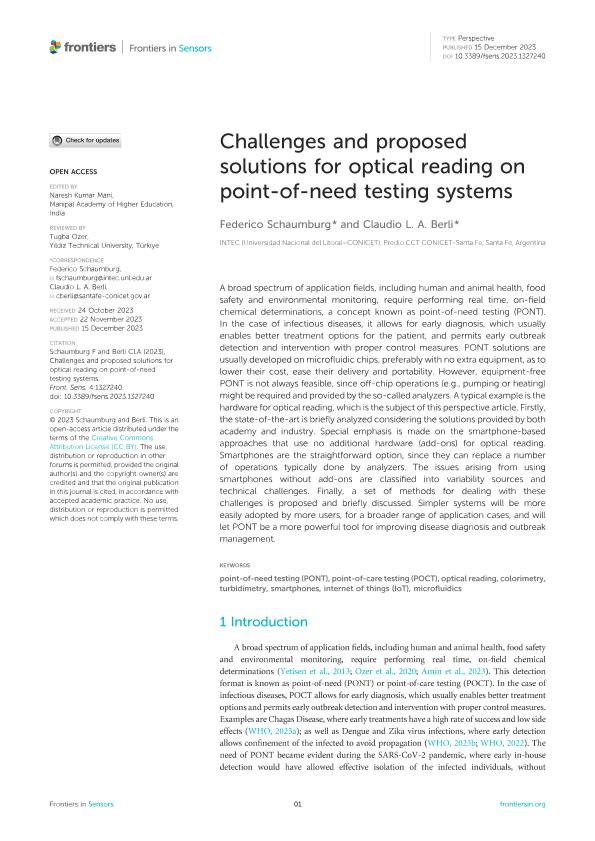Mostrar el registro sencillo del ítem
dc.contributor.author
Schaumburg, Federico

dc.contributor.author
Berli, Claudio Luis Alberto

dc.date.available
2024-02-02T17:40:24Z
dc.date.issued
2023-12
dc.identifier.citation
Schaumburg, Federico; Berli, Claudio Luis Alberto; Challenges and proposed solutions for optical reading on point-of-need testing systems; Frontiers Media; Frontiers in Sensors; 4; 12-2023; 1-7
dc.identifier.issn
2673-5067
dc.identifier.uri
http://hdl.handle.net/11336/225635
dc.description.abstract
A broad spectrum of application fields, including human and animal health, food safety and environmental monitoring, require performing real time, on-field chemical determinations, a concept known as point-of-need testing (PONT). In the case of infectious diseases, it allows for early diagnosis, which usually enables better treatment options for the patient, and permits early outbreak detection and intervention with proper control measures. PONT solutions are usually developed on microfluidic chips, preferably with no extra equipment, as to lower their cost, ease their delivery and portability. However, equipment-free PONT is not always feasible, since off-chip operations (e.g., pumping or heating) might be required and provided by the so-called analyzers. A typical example is the hardware for optical reading, which is the subject of this perspective article. Firstly, the state-of-the-art is briefly analyzed considering the solutions provided by both academy and industry. Special emphasis is made on the smartphone-based approaches that use no additional hardware (add-ons) for optical reading. Smartphones are the straightforward option, since they can replace a number of operations typically done by analyzers. The issues arising from using smartphones without add-ons are classified into variability sources and technical challenges. Finally, a set of methods for dealing with these challenges is proposed and briefly discussed. Simpler systems will be more easily adopted by more users, for a broader range of application cases, and will let PONT be a more powerful tool for improving disease diagnosis and outbreak management.
dc.format
application/pdf
dc.language.iso
eng
dc.publisher
Frontiers Media

dc.rights
info:eu-repo/semantics/openAccess
dc.rights.uri
https://creativecommons.org/licenses/by-nc-sa/2.5/ar/
dc.subject
POINT-OF-NEED TESTING (PONT)
dc.subject
OPTICAL READING
dc.subject
SMARTPHONES
dc.subject
INTERNET OF THINGS (IOT)
dc.subject.classification
Tecnología de Laboratorios Médicos

dc.subject.classification
Ingeniería Médica

dc.subject.classification
INGENIERÍAS Y TECNOLOGÍAS

dc.title
Challenges and proposed solutions for optical reading on point-of-need testing systems
dc.type
info:eu-repo/semantics/article
dc.type
info:ar-repo/semantics/artículo
dc.type
info:eu-repo/semantics/publishedVersion
dc.date.updated
2024-02-02T15:29:21Z
dc.journal.volume
4
dc.journal.pagination
1-7
dc.journal.pais
Suiza

dc.journal.ciudad
Lausanne
dc.description.fil
Fil: Schaumburg, Federico. Consejo Nacional de Investigaciones Científicas y Técnicas. Centro Científico Tecnológico Conicet - Santa Fe. Instituto de Desarrollo Tecnológico para la Industria Química. Universidad Nacional del Litoral. Instituto de Desarrollo Tecnológico para la Industria Química; Argentina
dc.description.fil
Fil: Berli, Claudio Luis Alberto. Consejo Nacional de Investigaciones Científicas y Técnicas. Centro Científico Tecnológico Conicet - Santa Fe. Instituto de Desarrollo Tecnológico para la Industria Química. Universidad Nacional del Litoral. Instituto de Desarrollo Tecnológico para la Industria Química; Argentina
dc.journal.title
Frontiers in Sensors
dc.relation.alternativeid
info:eu-repo/semantics/altIdentifier/url/https://www.frontiersin.org/articles/10.3389/fsens.2023.1327240/full
dc.relation.alternativeid
info:eu-repo/semantics/altIdentifier/doi/http://dx.doi.org/10.3389/fsens.2023.1327240
Archivos asociados
